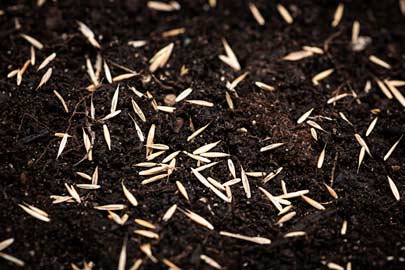If you’re like most people, recent hot weather has left your lawn screaming for attention. Now is the perfect time to assess your lawn trouble spots and think about seeding this fall to ensure a beautiful lawn when spring arrives.

When planting grass seed in the fall, time the seeding to allow the grass seed to fully germinate before freezing temperatures arrive in your region. It’s also important to take into account any weed controls you may have applied and allow an adequate wait period before seeding, as noted on the weed control product label.
Whether seeding a new lawn section or repairing a spot on an existing lawn, it is relatively easy to achieve success—simply follow these five steps for best results:
Step 1 – Buy the best grass seed
To get the best results, it’s vital to start with good seed. To find a top quality grass seed, look for seed which is independently evaluated by the National Turf Evaluation Program (NTEP). The NTEP rating on grass seeds ensures you are purchasing grass seeds that have been specifically bred for superior green grass color, disease and insect resistance and drought tolerance. When considering the price of grass seed, remember the price is small compared to the time that will be invested in building a great lawn. GreenView Pure Grass Seeds are all NTEP rated.
You may also want to spend some time researching what type of grass grows best in your area. Generally, grasses fall into two categories—cool season and warm season grasses. Cool season grass does well in northern and temperate climates, while southern season grasses grow best in the southern parts of the United States. If patching an already existing lawn, try to match your new seed with the type of lawn already in place. Nothing looks stranger than a patch of tall fescue, growing in a zoysia lawn.
Step 2 – Prepare the soil
For planting a new lawn section:
- Loosen the top 2 to 3 inches of soil.
- Remove debris (sticks, stones, etc) from the area.
- Break up soil clumps larger than a half dollar.
- Avoid soil that is too fine. Small clumps are acceptable.
- Level the areas where excess water might collect.
For overseeding an existing lawn:
- Mow grass as short as possible.
- Loosen the top ¼ inch of soil in bare spots.
- Remove debris and dead grass.
- Level the areas where excess water collects.
- After overseeding, fertilize the bare spots with a starter fertilizer like GreenView Starter Fertilizer. This ensures new seedlings get off to the right start.
Step 3 – Planting grass seed
- Spread the seed evenly by hand in small areas or using a hand-held spreader for larger areas.
- Apply approximately 16 seeds per square inch. Too many seeds too close together causes seedlings to fight for room and nutrients. Grass may be weak or thin in these areas.
Step 4 – Cover seeds
- Lightly drag the grass seed bed so no more than ¼ inch of soil covers the grass seed.
- Don’t forget to protect your seed once it’s down. Using a product like GreenView Fairway Formula Seeding Success provides a seeding mulch and start fertilizer in combination. This is intended to enhance the ideal growing conditions for your seed by providing important nutrients and helping keep the seed moist longer between waterings.
Step 5 – Water often
- Keep grass seed bed moist to enhance germination.
- Water lightly and frequently (at least once daily). Water until new grass is two inches high.
- Water new grass regularly to keep roots moist.